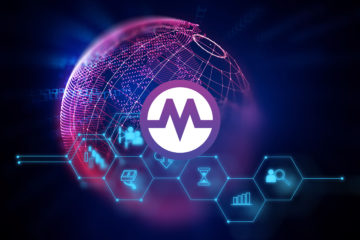Nexus has been continuing to make great strides, and I’m(as well as the whole community I imagine) appreciative to have such an active and open development team for the chain.
I feel as if the coin and the community supporting it both benefit greatly from it’s Ask Me Anything’s. Most crypto enthusiasts never get to hear the voice behind the technology, and Nexus is setting a great example for other’s in that aspect.
Here are the best take-aways from the live AMA. It’s important to note that there were many more questions asked, and answered via the Reddit AMA. These are only questions asked and answered from the live AMA.
Before you start reading, please note that the answer’s are my interpretation of Colin’s explanations. If you want to hear it from the man himself, watch the VOD.
Q: How Does The 3D Blockchain Work?
The AMA kicked off with Colin giving an explanation as to what the multi-dimensional chain is, and how it works. For those that are curious as to how it works, I’ve got a great write-up(that Colin assisted me with) here. This question has an answer that really deserves it’s own separate read. Nonetheless, Colin explained it to his best ability in the given time he had.
Q: How does the “future” Nexus Blockchain compare to Lightning Network supported coins?
A: Colin had admitted that Nexus may suffer from some scalability issues in the future in regards to speed and efficiency when compared to Lightning Network speeds, however it’s not something he’s worried about.
Q: How do the satellites work? What’s the plan for the general infrastructure?
A: Colin explained his plan with the satellites was intended to ensure that no 3rd party could easily interfere with the blockchain. The satellites would essentially replace the cross continental cables used for internet, and allow for the blockchain to be accessed globally from the Nexus launched satellites. This would ensure that no government or 3rd party could ever interfere with the blockchain, even if there were to be some kind of restriction on internet(like in some dictator controlled countries/nations).
The satellites are an alternative to running copper and fiber cables from nation to nation… Which would cost billions of dollars… Opposed to shooting up a few satellites for a much smaller investment.
In a sense, it’s a more open and decentralized alternative to using the internet, for accessing the blockchain.
It’s a great workaround to ISP, and government interference.
Q: How many satellites is Nexus planning to launch? What’s the cost? Who is Nexus working with to make it possible?
A: The satellites can range anywhere from $50,000 to $150,000 USD. Which is much cheaper than the standard $300,000,000 USD for a single cable.
The satellite coverage is extremely high, however not yet known, so the amount of satellites needing to be deployed is an unknown factor.
The satellites depending on it’s set orbit can last anywhere from five to ten years.
Nexus is currently working with Vector Space Systems, on the software and satellite hardware.
The satellites will be launched by average users, thanks to a currently unknown incentive system… This alleviates the financial stress from Nexus itself. The goal is to provide users with the tools and incentives to make Nexus expand opposed to Nexus doing all the work itself.
Q: What’s the current status of the satellites, what are the challenges involved?
A: At the moment Nexus is working on manufacturing it’s first test/beta satellite.
The biggest challenge Colin stated, was providing it’s function while complying with the ITU(International Telecommunications Union) and other regulations.
Another difficulty is that many countries have a different set of regulations, as to what frequencies the satellites are permitted to function on.
Colin stated that he will be getting experimental licenses/permissions to test his satellites on specified frequencies “sooner rather than later” for the United States.
There are many variables in play, however Nexus is determined to make it happen.
Q: So, the plan is to… Replace the internet?
A: No, the plan is to provide an alternative internet that’s powered by the people instead of ISP’s and governments. This alternative internet could in theory be used in conjunction with the standard internet we know of today. However, giving people the option(and incentive) to use a more free and open uncensored peer to peer connection is the main goal.
Q: Was Nexus ever an ICO, if so what’s the funding going toward?
A: Nexus never had an ICO, and had been around way before the mainstream creation of ICO’s.
The network genesis block was mined in September, of 2014.
Q: Will Nexus ever have an IOS wallet, and how will staking work on it?
A: Yes, Nexus plans on creating an IOS wallet. In-fact there’s some development going on for it now.
Staking would work the same way that it works on PC. Thankfully you won’t need to hold the entire blockchain on your device, and the application will run efficiently in the background.
Q: Will Nexus also end up as a free cell phone service of sorts?
A: Although it’s not the main goal, it’s definitely possible although there are lots of variables in play.
This would very based on your Mesh network master, and other hardware dependencies.
But yes, it is a possibility that you could use the blockchain for that, technically.
Q: Are you worried about quantum computing?
A: It’s always going to be a concern, and should be for all blockchains.
However, with Nexus the highest possible key values are being used, and the team always has it on their mind.
All cryptography can eventually be cracked. However, as it continues to evolve, it’s important to use the newest found practices to ensure that quantum machines can’t catch up… Which is exactly what Nexus is doing.
Q: How is Nexus making it’s service easy to use, and understand for average users?
A: Tritium is the wallet system in which is a major tool that will stress the importance of easy use.
To start, it will appear to represent your standard bank account in a lot of ways by requiring a user/pass/pin to access your funds/personal ledger.
It will also have the proper scaling needed, to ensure transactions are sent quick… And don’t take days, like with most Bitcoin transactions.
The user interface is also one of the Tritium wallet’s big selling points. Nexus plans on making everything as easy and grandma-friendly possible.
Q: Where do you see Nexus going within’ the next three years?
A: Within the next three years, Nexus plans on releasing it’s new frameworks, one-by-one. Providing each different dimension to it’s multi-dimensional chain as time goes on, and code reaches completion.
Q: What partnerships does Nexus currently have?
A: Vector Space Systems, which is assisting with the satellite aspect of things(mentioned above).
Singularity Net, which are currently working on implementing AGI(Artificial General Intelligence) into blockchain technology. Their role is building an efficient trust system that acts almost as the human immune system, in detecting bad players/nodes within the chain.
Lisp(Location Identifier Separation Protocol), developed by one of the original Cisco engineers… Assisting with network architecture, and etc.
There are plenty of other individuals that are assisting, however the above mentioned three are the currently only “Official” partners. Future partnerships will of course be announced.
In Conclusion
The fifty or so minute AMA went amazingly, aside from Colin being roughly five minutes late, tisk tisk..
The community had asked some excellent questions, and Colin had done an amazing job answering all of them to the best ability.
I feel as if even those who didn’t have any questions and participated in the AMA had benefited… I know I did(even though I missed it and had to watch the VOD).




0 Comments